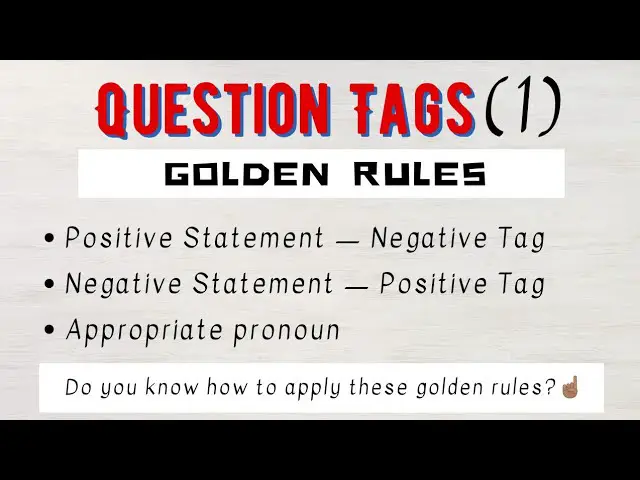A question tag is a “tag” at the end of a statement to make it a “question”.
Learn the basic rules of question tags in English with examples and questions for you to practice.
▶️ Watch this lesson
Examples of question tag
- isn’t he?
- are they?
- didn’t she?
Structure of question tags
See from the examples above that a question tag is made up of just two words — a verb first, then a pronoun.
- A verb (is, are, did, etc.)
- A pronoun (he, she, they, etc.)
In a full sentence format, you’d have two structures — the statement first before the question tag.
- The statement (He is at home.)
- The question tag (isn’t he?)
Basic rules of question tags in English
A statement or question tag is negative when it contains “not, no, none” or any other word that indicates absence.
- Did not (Didn’t)
- No one…
- None of…
While a statement or question tag is positive in the absence of “not, no, none”.
- Did
- One of...

1. Use negative tag for positive statement
When the statement is positive, use a negative question tag.
- She is here — (POSITIVE STATEMENT)
- Isn’t she? — (NEGATIVE TAG)
2. Use positive tag for negative statement
When the statement is negative, use a positive question tag.
- She is not here — (NEGATIVE STATEMENT)
- Is she? — (POSITIVE TAG)
3. Change the subject to a pronoun
When the subject in the statement is a noun (name), change it to the correct pronoun in the question tag.
- DEBORAH is here
- Isn’t SHE?
Another example.
- MUSA and CHUKS are best friends
- Aren’t THEY?
Practice questions on rules of question tags in English
ALSO SEE:
- QUESTION TAGS WITH AUXILIARY VERB
- QUESTION TAGS WITHOUT AUXILIARY VERBS
Do you have something to say about this post on the rules of question tags in English? Let me know in the comments below.

 I am Sam O. and ‘I teach English online’ to bridge the gap between sincere students and quality English lessons.
I am Sam O. and ‘I teach English online’ to bridge the gap between sincere students and quality English lessons.
Leave a Reply